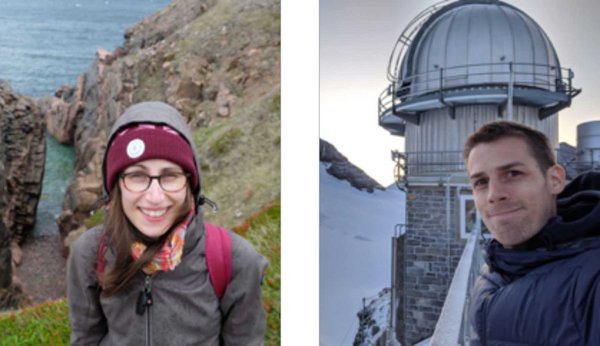
Ellen Gute (University of Toronto, Canada, photo on the left) and Cyril Brunner (ETZ Zurich, Switzerland, photo on the right), two doctoral students, have created a successful format: The "virtual INP Colloquium". (Photos: private)

New pathways for scientific communication: Ice particle researchers meet virtually once a month
Since March, a new communication format is live to bring the international community of cloud research together. Once a month, the "virtual INP Colloquium" provides the research community with a platform to present new findings and discuss with peers. The colloquium focusses on a specialized field of cloud research: Ice nucleating particles (INPs) which are highly relevant for ice formation in clouds and with this influence precipitation formation and how clouds reflect sunlight and thermal radiation.
Ellen Gute (University of Toronto, Canada, photo on the left) and Cyril Brunner (ETZ Zurich, Switzerland, photo on the right), two PhD Candidates, have initiated the successful format: online colloquia around the topic they both conduct research on themselves. The colloquia take place monthly, on August 4 for the 4th time. The time of day (5 pm in Central Europe) allows scientists around the world to participate. So far, there has been active participation from around the world, with about 120 participants joining each colloquium and bringing people together from Japan and China to Canada and the US.
Heike Wex from TROPOS presented herself at the August 4th colloquium and was pleased: "With the colloquium, everyone around the world working on the topic of ice nucleation can be reached. The reach is beyond what is usually possible at many conferences or workshops. And attending such conferences and workshops usually requires long journeys. During the online colloquium, everyone can discuss or ask questions. I think that in the future we will notice that open questions can be dealt with very efficiently in a scientific community through such formats".
Ellen and Cyril explain that the idea for the virtual colloquium format developed soon after nearly everyone in academia and beyond found themselves working in home office in spring this year: "Weekly group meetings were now held virtually and we found that the exchange with colleagues is extremely valuable especially during times spent in home office, whether as a presenter or attendee. And so, we wondered why not increase the group size to include the entire ice nucleation research community? Technical resources were available and the additional effort to organize a colloquium is very modest. Moreover, we see the online colloquium as an opportunity to explore how we can effectively communicate our research without the need to travel long distances by plane. Beyond saving CO2 emissions, the online colloquia format allows a larger audience to participate and makes discussions more accessible. To attend the remote colloquia, no travel funds are required and other duties and responsibilities potentially limiting travel (e.g. childcare) can still be fulfilled, allowing especially early career researchers to better engage in the scientific discussions. ".
The future will show how successful this format can be in promoting scientific exchange while reducing travel activities. Overall, we strongly recommend that other research areas give it a try too!

Ellen Gute (University of Toronto, Canada, photo on the left) and Cyril Brunner (ETZ Zurich, Switzerland, photo on the right), two doctoral students, have created a successful format: The "virtual INP Colloquium". (Photos: private)